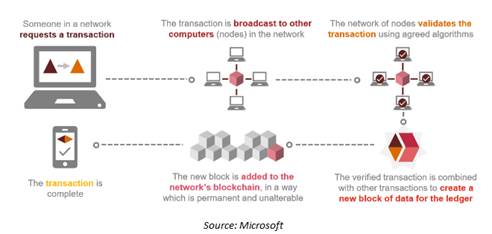Have you ever had too much or too little inventory burning through your profit margins due to warehousing and storage? Maybe the latest paper invoices from your manufacturer have gone missing and you’re scrambling to locate them – Again. How about the lack of communication from the vendors within your supply chain? What about your brand’s data? Is it secure, even as it is split and stored by multiple parties in separate data silos? Are the transactions all along your supply chain being accurately logged, verified, and stored?
As fashion brand logistics have become increasingly complex, disruptions inevitably impact even the most well-planned modern supply chain. Whether these are due to simple human error, lack of communication, or natural events like the COVID-19 pandemic, the end result is the same – your goods failing to reach your retail partners or customers’ doorsteps in a timely manner, and damage to your brand’s image and reputation.
Fortunately, technological advancements have improved supply chain efficiency. One such innovation is blockchain technology. At first glance, you may think I’m talking about Bitcoin and Ethereum, right? Wrong. Those are cryptocurrencies, seen as an alternate form of money compared to your traditional government dollar. Blockchains are the secure, digitized ledgers in which these cryptocurrencies are rooted. Today, they have also developed the potential to mitigate risks across your brand’s logistics network, providing end-to-end visibility, automated workflows that streamline shipping and storage processes, and a secure ledger of all transaction data along the supply chain. With these benefits in mind, should your brand consider adopting blockchain into its logistics network? Let’s take a closer look.
What Is a Blockchain?

In its simplest form, a blockchain is a digitized ledger that electronically stores transaction data. Compared to traditional databases that use tables, single-source entities, and trusted third parties to store information, blockchains are structured to store data into small groups of information, known as blocks, that are validated, verified, and shared across an entire network of stakeholders. When one block reaches its storage capacity, a new block is formed linked to the previous one, resulting in a linear, chronological chain of data as it is being sent and received across a blockchain network. The information stored inside can be traced to the specific point in time the block was created and cannot be altered without stakeholder consensus. This guarantees the security, transparency, and reliability of a database without the need of a trusted third party.
Blockchain-Enabled Transparency and Traceability

For supply chain logistics, blockchain presents a potential solution to locating when and where disruptive errors occurred along the transfer of your inventory from point A to point B. Currently, financial ledgers and enterprise resource planning systems (ERP) are the main staple for conducting supply chain management operations. They aid in:
1. Product Planning
2. Inventory Management
3. Supplier Interactions
4. Order Tracking
Yet, they do not reliably allow the parties within a supply chain transaction to see all the relevant flows of finance, information, and inventory. Even a simple transaction between a fashion brand and its suppliers and manufacturers will involve certain blind spots, where a lack of communication opens the door to execution errors involving inventory data, missed shipments, and duplicate payments. These errors cannot be detected in real-time and even though ERP systems capture all types of flows across the supply chain, pinpointing and assessing which entries in the ERP correspond with which inventory transaction is time consuming and expensive when an execution error occurs.
Blockchain can change this by providing better visibility, transparency, and traceability in the supply chain through:
1. Tokenization – Your brand’s assets (inventory, orders, bills of lading, etc.) are divided and converted into readily verifiable identifiers serving as trackable digital tokens for transactions within the blockchain.
2. Digital Signatures – Participants in a blockchain are given unique digital signatures to “sign” tokens as they move through the blockchain. In the creation of a new block by a participant, their digital signature verifies that they are the origin of the block, and each subsequent transaction afterwards creates a built-in audit trail visible to all.
3. Smart Contracts - A smart contract is a program of written code stored on a blockchain that executes a specific task when certain predetermined conditions are met. Acting as a digital agreement between transacting parties, they automate specific supply chain management operations without the need for intermediaries. These actions can include releasing payments, recording ledger entries, quality assurance checks, and flagging instances requiring manual intervention. They improve supply chain speed and efficiency and reduce the overall amount of human intervention and paperwork involved in end-to-end operations.
4. Enhanced Security – Protecting your brand’s data is important. Using a method known as cryptography, the blockchain encrypts the messages sent along it to protect and secure users’ data. Thanks to this encryption, a hack or overwrite of past data in the blockchain would require rewriting all the subsequent blocks on the chain.
Remember, blockchains are linear, chronological chains of data that cannot be altered, and every created block needs to be verified by all the stakeholders. By having consensus mechanisms and smart contracts in place, an execution error can be spotted in real-time, as it was not verified and did not meet the conditions set forth by the smart contracts. However, in the event that an execution error does slip through the blockchain, locating its source is simple. You can identify the specific asset in which the error occurred thanks to tokenization, view its transaction log, and note the digital signature of the original creator of the errant block. Upon identifying the party who created the error, the appropriate actions can be taken to ensure accountability in your supply chain.

Should Your Brand Consider Using Blockchain?
Like all things that sound “too good to be true,” blockchain does have limitations and pitfalls that have impacted mass adoption in fashion and across the entire logistics sphere. Blockchain developers are currently searching and developing solutions to address these key issues:
1. Scalability – Fashion supply chains handle thousands of different types of transactions daily. With blockchain, current limitations in block storage capacity reduce the transaction speeds across the network, heightened by the addition of more stakeholders into the chain. The problem is, simply increasing the storage capacity of a block congests the network further and reducing the size of the block puts the security of the blockchain at risk. That’s because, in the latter instance, hundreds of blocks in the chain could be formed before an error is noticed by the network.
2. Interoperability – Currently, blockchain networks do not communicate with each other and operate in their own separate data silos. A fashion brand using blockchain A will not be able to communicate with a supplier who uses blockchain B. Both parties need to operate in either blockchain A or B to communicate their supply chain operations with each other.
3. Energy Consumption – With fashion trying to reduce its environmental footprint, implementing a blockchain that uses a proof-of-work consensus mechanism could be detrimental to the brand’s image and reputation. Proof-of-work relies on high computing power in order to verify transactions over the blockchain network. The alternative is a proof-of-stake consensus which relies on significantly less computing power but requires stakeholders to “stake” cryptocurrency assets as collateral.
If your brand does decide to implement blockchain into its logistics network, it is important to consider the following factors:
1. Should you use a private or public blockchain? – Public blockchains allow for anyone to join and interact on the blockchain network. All transactions are secured, visible, and can be accessed as public information. On a private blockchain, only verified parties are allowed onto the network via an invitation from a centralized party who controls who can participate in the network. However, due to the centralized nature of a private blockchain, the owner of a private blockchain has the right to override, edit, or delete entries which could affect transparency and traceability.
2. What are your areas of concern? – Identify areas along the supply chain where you believe blockchain will benefit your fashion brand. Is it in managing inventory? Tracking shipments? Transparency and communication? Having a strategy in place will aid in allocating and developing the proper resources towards blockchain implementation.
3. Start small and scale up. – Completely overhauling your logistics network to use blockchain technology is impractical and could be detrimental to your brand. Develop a small ecosystem focused on performing specific tasks within your supply chain to evaluate a blockchain’s performance in meeting your brand’s logistics needs compared to ERPs.
Blockchain has the potential to be a powerful tool for addressing current supply chain deficiencies. As the technology continues to develop, it could ultimately revolutionize how logistics is conducted as a whole across the entire fashion supply chain. An investment in the technology today could reap great rewards for your brand and in turn, build the trust, transparency, and traceability it seeks among its consumers and its partners.
This article has not been edited by Fibre2Fashion staff and is re-published with permission from makersvalley.net.








Comments